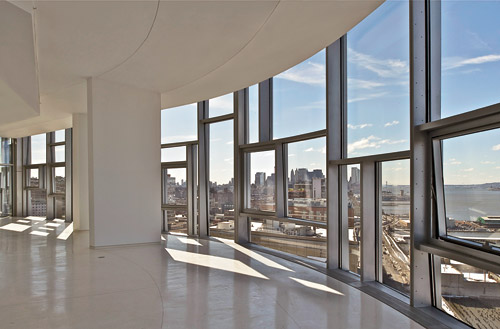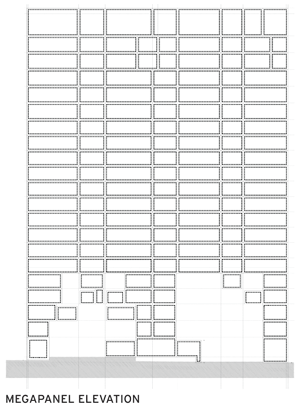Behind the Curtain Wall
 |
The anodized aluminum mullions match the silver-painted steel sections on the inside. Photo: © Philippe Ruault |
Â
The aluminum mullions also provide the waterproofing (which steel is not good at doing). The waterproofing consists of a series of gaskets and sealant. The cruciform joint where four panels come together is an injection-molded accordion gasket. According to Simmons, "It is a common approach to combine the design intelligence of aluminum with the robust, abstract nature of a steel backup."
 |
A regular grid of megapanels contains the more random composition of smaller frames. Most floors feature seven megapanels. |
The aluminum caps on the front of the facade vary in depth to create a variety of shadow lines over the building. "There is no visual plane that has any dimensional stability," says Simmons. "It is a very complex but organic assembly."
According to Leininger, the tilting planes and various materials create a patchwork of colors and reflections. "From one angle you catch glimpses of the Gehry building; from another,
the sky and sunset."
For the lower apartments that do not have views out to the river, Nouvel offers a different amenity. A thin wall rises several stories as a buffer between the building and the street. The design calls for a vertical garden within that 15-foot-wide space, where trees will be planted at different heights. "From the same apartment, you may see the top of one tree and the trunk of another," Leininger explains.
Interestingly, while the facades of all three buildings - Beekman Tower, One Jackson Square, and 100 Eleventh Avenue - push the limits of construction with their groundbreaking uses of metal and glass, all prominently feature traditional masonry walls as well.
While the undulating glass wall of One Jackson Square reflects the brick buildings surrounding it, the brick of its own back wall serves practical purposes. Because the building sits above a subway tunnel, it required a robust structure. The masonry wall takes the lateral loads on the building and brings them down into the foundation.
The other two buildings include brick to address their immediate contexts. In Beekman Tower, the first five floors - which will house a primary school, office and retail space, and the residential lobby - are clad in buff-colored brick, and act as a simple pedestal for the sculptural form of the tower above. "For better or worse, it was my decision to make the bottom matter-of-fact so it fit in with the rest of the neighborhood," says Gehry. "There's enough height that the rest of the architecture is pretty damn strong."
For 100 Eleventh Avenue, the view from the east is a much different one than the shimmering glass wall that faces the water. The solid wall on this side of the building takes a more minimal approach - its black brick punctuated by a few randomly arranged windows on each floor. According to Leininger, a key to understanding the building's envelope is recognizing the diversity of its context. "There is the contrast of wide open views to the river from the transparent steel-and-glass facade, and the specific views to Midtown - like paintings on a wall - from the punched windows of the brick facade."








